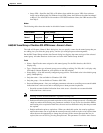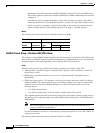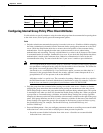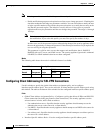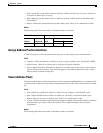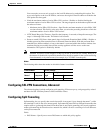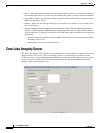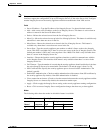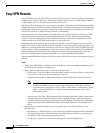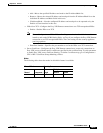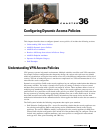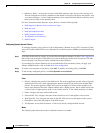
35-83
Cisco ASDM User Guide
OL-16647-01
Chapter 35 General
Zone Labs Integrity Server
Note The current release of the security appliance supports one Integrity Server at a time even though the user
interfaces support the configuration of up to five Integrity Servers. If the active Server fails, configure
another Integrity Server on the security appliance and then reestablish the client VPN session.
Fields
• Server IP address—Type the IP address of the Integrity Server. Use dotted decimal notation.
• Add—Adds a new server IP address to the list of Integrity Servers. This button is active when an
address is entered in the Server IP address field.
• Delete—Deletes the selected server from the list of Integrity Servers.
• Move Up—Moves the selected server up in the list of Integrity Servers. This button is available only
when there is more than one server in the list.
• Move Down—Moves the selected server down in the list of Integrity Servers. This button is
available only when there is more than one server in the list.
• Server Port—Type the security appliance port number on which it listens to the active Integrity
server. This field is available only if there is at least one server in the list of Integrity Servers. The
default port number is 5054, and it can range from 10 to 10000. This field is only available when
there is a server in the Integrity Server list.
• Interface—Choose the interface security appliance interface on which it communicates with the
active Integrity Server. This interface name menu is only available when there is a server in the
Integrity Server list.
• Fail Timeout—Type the number of seconds that the security appliance should wait before it declares
the active Integrity Server to be unreachable. The default is 10 and the range is from 5 to 20.
• SSL Certificate Port: Specify the security appliance port to be used for SSL Authorization. The
default is port 80.
• Enable SSL Authentication—Check to enable authentication of the remote client SSL certificate by
the security appliance. By default, client SSL authentication is disabled.
• Close connection on timeout—Check to close the connection between the security appliance and the
Integrity Server on a timeout. By default, the connection remains open.
• Apply—Click to apply the Integrity Server setting to the security appliance running configuration.
• Reset—Click to remove Integrity Server configuration changes that have not yet been applied.
Modes
The following table shows the modes in which this feature is available:
Firewall Mode Security Context
Routed Transparent Single
Multiple
Context System
• — • ——



